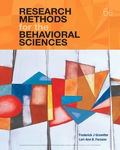
Research Methods for the Behavioral Sciences (MindTap Course List)
6th Edition
ISBN: 9781337672023
Author: GRAVETTER
Publisher: Cengage
expand_more
expand_more
format_list_bulleted
Concept explainers
Textbook Question
Chapter 1, Problem 10E
Describe what it means to say that science is empirical, public, and objective, and explain why each of these principles is important.
Expert Solution & Answer
Trending nowThis is a popular solution!

Students have asked these similar questions
AP1.1 You look at real estate ads for houses in Sarasota, Florida. Many houses range from $200,000 to $400,000 in price. The few houses on the water, however, have prices up to $15 million. Which of the following statements best describes the distribution of home prices in Sarasota?
The distribution is most likely skewed to the left, and the mean is greater than the median.
The distribution is most likely skewed to the left, and the mean is less than the median.
The distribution is roughly symmetric with a few high outliers, and the mean is approximately equal to the median.
The distribution is most likely skewed to the right, and the mean is greater than the median.
The distribution is most likely skewed to the right, and the mean is less than the median.
During busy political seasons, many opinion polls are conducted. In apresidential race, how do you think the participants in polls are generally selected?Discuss any issues regarding simple random, stratified, systematic, cluster, andconvenience sampling in these polls. What about other types of polls, besides political?
Please could you explain why 0.5 was added to each upper limpit of the intervals.Thanks
Chapter 1 Solutions
Research Methods for the Behavioral Sciences (MindTap Course List)
Ch. 1.1 - Compare and contrast the nonscientific methods for...Ch. 1.2 - Identify and describe the steps of the scientific...Ch. 1.2 - Define induction and deduction and explain the...Ch. 1.2 - Distinguish between a hypothesis and a prediction.Ch. 1.2 - Explain what it means to say that the scientific...Ch. 1.2 - Prob. 6LOCh. 1.3 - Distinguish between qualitative and quantitative...Ch. 1.3 - Identify and describe the steps in the research...Ch. 1 - In addition to the key words that were defined in...Ch. 1 - Describe how some behaviors can be explained by...
Ch. 1 - Describe why you might be cautious about using the...Ch. 1 - Suppose that you are debating whether to hitchhike...Ch. 1 - According to the gamblers fallacy, if a coin toss...Ch. 1 - In this chapter, we identified the method of...Ch. 1 - What are the five steps of the scientific method?Ch. 1 - Describe the difference between inductive and...Ch. 1 - State a hypothesis that identifies a specific...Ch. 1 - Describe what it means to say that science is...Ch. 1 - An expert appears on a shopping network to explain...Ch. 1 - A social science researcher would like to...
Knowledge Booster
Learn more about
Need a deep-dive on the concept behind this application? Look no further. Learn more about this topic, statistics and related others by exploring similar questions and additional content below.Similar questions
- 28. (a) Under what conditions do we say that two random variables X and Y are independent? (b) Demonstrate that if X and Y are independent, then it follows that E(XY) = E(X)E(Y); (e) Show by a counter example that the converse of (ii) is not necessarily true.arrow_forward1. Let X and Y be random variables and suppose that A = F. Prove that Z XI(A)+YI(A) is a random variable.arrow_forward30. (a) What is meant by the term "product measur"? ANDarrow_forward
- (c) Describe the positive and negative parts of a random variable. How is the integral defined for a general random variable using these components?arrow_forward26. (a) Provide an example where X, X but E(X,) does not converge to E(X).arrow_forward(b) Demonstrate that if X and Y are independent, then it follows that E(XY) E(X)E(Y);arrow_forward
arrow_back_ios
SEE MORE QUESTIONS
arrow_forward_ios
Recommended textbooks for you
 Algebra for College StudentsAlgebraISBN:9781285195780Author:Jerome E. Kaufmann, Karen L. SchwittersPublisher:Cengage Learning
Algebra for College StudentsAlgebraISBN:9781285195780Author:Jerome E. Kaufmann, Karen L. SchwittersPublisher:Cengage Learning Trigonometry (MindTap Course List)TrigonometryISBN:9781305652224Author:Charles P. McKeague, Mark D. TurnerPublisher:Cengage LearningAlgebra & Trigonometry with Analytic GeometryAlgebraISBN:9781133382119Author:SwokowskiPublisher:Cengage
Trigonometry (MindTap Course List)TrigonometryISBN:9781305652224Author:Charles P. McKeague, Mark D. TurnerPublisher:Cengage LearningAlgebra & Trigonometry with Analytic GeometryAlgebraISBN:9781133382119Author:SwokowskiPublisher:Cengage Algebra: Structure And Method, Book 1AlgebraISBN:9780395977224Author:Richard G. Brown, Mary P. Dolciani, Robert H. Sorgenfrey, William L. ColePublisher:McDougal Littell
Algebra: Structure And Method, Book 1AlgebraISBN:9780395977224Author:Richard G. Brown, Mary P. Dolciani, Robert H. Sorgenfrey, William L. ColePublisher:McDougal Littell

Algebra for College Students
Algebra
ISBN:9781285195780
Author:Jerome E. Kaufmann, Karen L. Schwitters
Publisher:Cengage Learning

Trigonometry (MindTap Course List)
Trigonometry
ISBN:9781305652224
Author:Charles P. McKeague, Mark D. Turner
Publisher:Cengage Learning

Algebra & Trigonometry with Analytic Geometry
Algebra
ISBN:9781133382119
Author:Swokowski
Publisher:Cengage

Algebra: Structure And Method, Book 1
Algebra
ISBN:9780395977224
Author:Richard G. Brown, Mary P. Dolciani, Robert H. Sorgenfrey, William L. Cole
Publisher:McDougal Littell
Probability & Statistics (28 of 62) Basic Definitions and Symbols Summarized; Author: Michel van Biezen;https://www.youtube.com/watch?v=21V9WBJLAL8;License: Standard YouTube License, CC-BY
Introduction to Probability, Basic Overview - Sample Space, & Tree Diagrams; Author: The Organic Chemistry Tutor;https://www.youtube.com/watch?v=SkidyDQuupA;License: Standard YouTube License, CC-BY